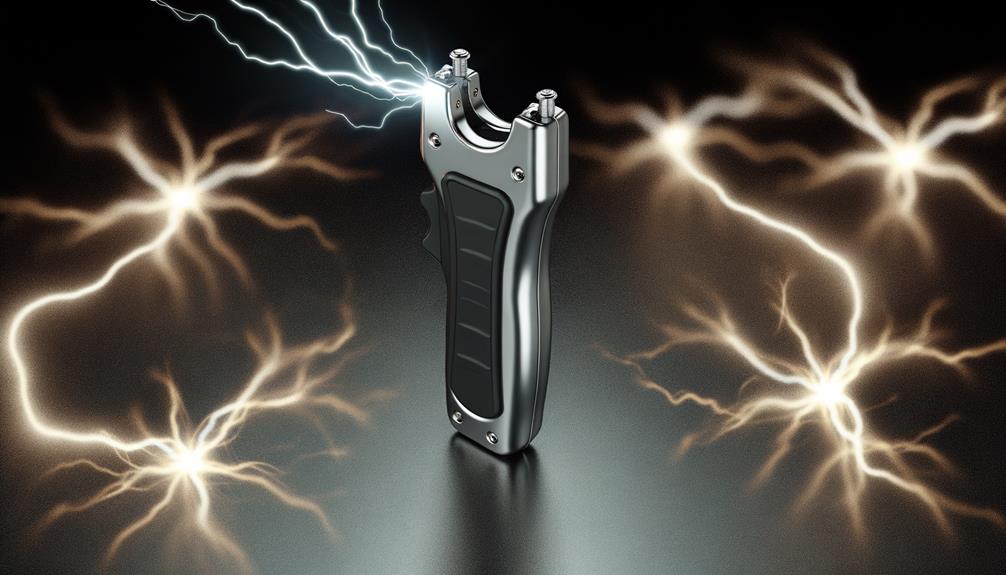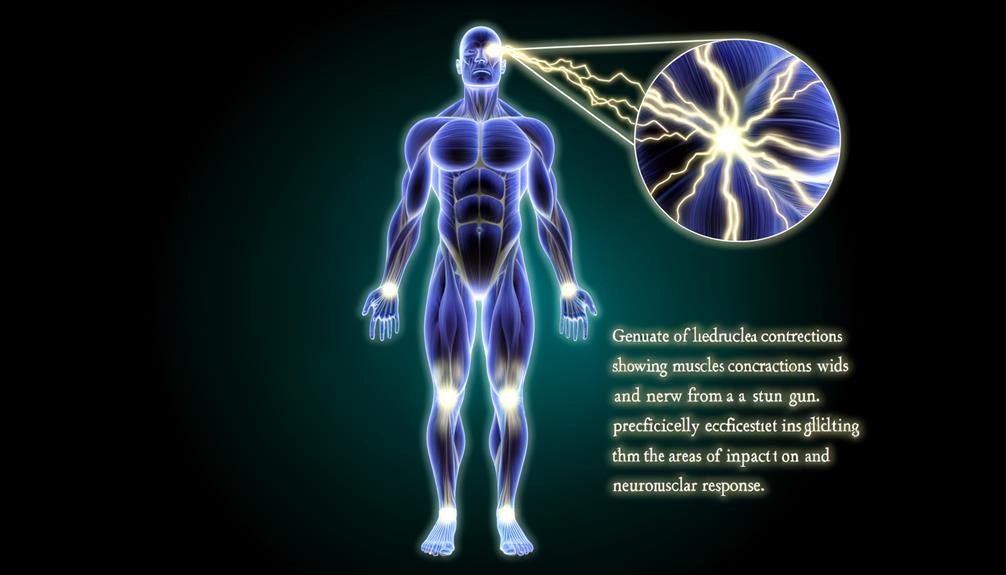
Brainstorm Security Shop

For Orders Over $199

On Any Of Our Products

Details On Refund Page

Stun guns are intriguing devices that utilize a high-voltage electrical pulse to incapacitate an assailant temporarily. By disrupting normal muscle function and nerve impulses upon contact, they offer a non-lethal means of self-defense. However, understanding the intricate components and underlying science that make these devices effective is essential for informed use. As we explore the various types and their legal implications, one must consider the broader impact of such technology on personal safety and ethical considerations. What lies beneath the surface of this seemingly straightforward tool?
Stun guns, as essential self-defense tools, consist of several critical components that work in unison to deliver an incapacitating electrical charge. The primary components include the power source, circuitry, and electrodes, each playing a vital role in the device’s functionality.
The power source, typically a rechargeable battery, provides the necessary voltage to generate the electric shock.
Stun gun technology has evolved significantly since its inception, which can be traced back to the early 20th century. Initially designed for law enforcement, the devices have been adapted for civilian use, reflecting their growing popularity in personal safety.
The circuitry is engineered to convert the battery’s stored energy into a high-voltage pulse, ensuring that even a brief contact with the electrodes can incapacitate an attacker.
Lastly, the electrodes, usually made of metal, deliver the electrical charge to the target upon contact. Their design and spacing are crucial, as they determine the effectiveness and range of the stun gun.
Understanding these components is essential for recognizing how stun guns operate and the advancements that have shaped their development throughout stun gun history.
Electric shock occurs when an electrical current passes through the body, disrupting normal physiological functions. Understanding the science of electric shock requires a grasp of electricity basics, including the nature of electrical currents, resistance, and conduction.
When an electric current flows through the body, it can interfere with the electrical signals that control muscle contractions and nerve impulses, potentially leading to a range of physical effects.
Shock therapy, a medical application of electrical stimulation, is a controlled use of electricity to treat various conditions, such as depression. This therapeutic approach contrasts sharply with unintentional electric shocks, which can cause severe injuries or fatalities.
The severity of an electric shock depends on several factors, including the current’s intensity, duration of exposure, and the pathway it takes through the body.
Low-voltage currents can lead to painful muscle contractions and disorientation, while higher voltages can result in serious injuries, including cardiac arrest.
Consequently, understanding the underlying principles of electricity and its physiological effects is crucial in both medical and self-defense contexts, such as the use of stun guns, where controlled electric shocks are employed for incapacitation rather than harm.

Stun guns operate through a mechanism of electrical discharge that significantly impacts the body’s neuromuscular system.
When the device is activated, it delivers a high-voltage pulse that disrupts normal muscle function, leading to temporary incapacitation.
This physiological effect is crucial for understanding both the intended use and potential risks associated with stun gun applications.
A significant aspect of how stun guns incapacitate an assailant lies in their electrical discharge mechanism, which disrupts normal bodily functions. This mechanism relies on the principles of electrical conductivity, allowing the stun gun to deliver a high-voltage, low-amperage charge through the body. When the electrical discharge enters the body, it interferes with the electrical signals that control muscle movements and coordination, leading to temporary incapacitation.
The effectiveness of a stun gun’s electrical discharge can be understood through the following table:
| Element | Function | Impact on Body |
|---|---|---|
| Voltage | Initiates electrical flow | Causes muscle contractions |
| Amperage | Determines shock intensity | Affects nerve signal transmission |
| Duration | Length of discharge pulse | Influences recovery time |
Understanding the electrical discharge mechanism is crucial for ensuring stun gun safety. Proper usage can maximize effectiveness while minimizing the risk of unintended harm. Overall, the intricate interplay of voltage, amperage, and duration in a stun gun’s electrical discharge is what facilitates its ability to incapacitate without causing permanent injury.
The neuromuscular disruption effects of stun guns are critical to understanding how these devices incapacitate an assailant. When activated, stun guns emit electrical impulses that interfere with the normal functioning of the body’s neuromuscular system. These electrical impulses induce involuntary muscle contractions, resulting in temporary loss of control over bodily movements.
The pain response triggered by these contractions is significant, causing immediate discomfort and disorientation. This is particularly effective in combat scenarios, where an assailant may be temporarily incapacitated, allowing the intended target to escape or counteract the threat.
The physiological responses can vary based on factors such as proximity, duration of exposure, and individual tolerance, adding complexity to the effectiveness of incapacitation techniques.
While stun guns are generally viewed as non-lethal alternatives for self-defense, safety concerns remain. Prolonged exposure or misuse can lead to severe injury or even fatal outcomes, underscoring the importance of responsible usage.
Understanding the neuromuscular effects of stun guns not only highlights their potential efficacy but also emphasizes the need for proper training and awareness in their application.
Among the various options on the market, stun guns can be categorized based on their design, functionality, and intended use. Tactical stun guns are designed for law enforcement and military applications, featuring rugged designs and higher voltage outputs for maximum effectiveness.
These are often paired with various stun gun accessories, such as holsters and rechargeable options, enhancing their utility in critical situations.
For personal safety, smaller and more discreet stun guns are available, including miniature models that can easily fit in a pocket or purse. These personal safety devices provide a non-lethal alternative for self-defense, allowing users to incapacitate an attacker without causing permanent harm.
Additionally, many manufacturers offer rechargeable options, reducing the need for constant battery replacements and ensuring that the device is ready when needed.
For those interested in self-defense training, various courses are available, focusing on the effective use of stun guns and situational awareness.
It is essential to note that potential users should familiarize themselves with any legal restrictions regarding stun gun ownership and usage in their area, as regulations can vary significantly.

Understanding the legal considerations surrounding stun guns is essential for potential users, as regulations can vary significantly from state to state.
Some jurisdictions permit their use for self-defense, while others impose strict limitations or outright bans.
Familiarizing oneself with these laws ensures compliance and promotes responsible usage in permitted scenarios.
Navigating the legal landscape surrounding stun guns reveals a patchwork of regulations that vary significantly from state to state.
These regulatory differences stem from varying interpretations of self-defense laws, public safety concerns, and local ordinances. Consequently, individuals considering the use of stun guns must familiarize themselves with the specific state laws and enforcement practices applicable in their area.
Key considerations include:
It is crucial for potential stun gun users to understand these nuances to avoid legal repercussions.
Failure to comply with state laws and local ordinances can result in significant legal liabilities, undermining the intended purpose of self-defense.
Thus, thorough research and awareness of the legal framework are essential for responsible stun gun ownership.
Permitted usage scenarios for stun guns are crucial to comprehend within the context of legal considerations, as these devices are primarily intended for self-defense. The legality of using a stun gun varies by jurisdiction, emphasizing the importance of understanding local laws before acquiring one. Generally, stun guns are permissible in self-defense situations where an individual reasonably perceives an imminent threat to their personal safety.
In many areas, the use of stun guns is authorized for defense against physical assaults or aggressive behavior. However, using a stun gun in non-threatening situations or for purposes of intimidation can lead to legal repercussions. It is vital to establish that the usage aligns with the principle of proportionality; the response must be commensurate with the perceived threat.
Furthermore, some states impose restrictions on the possession of stun guns, necessitating a review of specific regulations. Individuals should familiarize themselves with these laws to ensure compliance and avoid potential criminal charges.
Ultimately, understanding permitted usage scenarios not only promotes responsible ownership but also reinforces the primary intent of stun guns as tools for personal safety in legitimate self-defense situations.
Utilizing stun guns effectively requires adherence to best practices that ensure both personal safety and compliance with legal regulations. Responsible ownership of a stun gun entails understanding its operation, potential risks, and the legalities surrounding its use. Proper safety training is essential for anyone considering this self-defense tool.
Here are some best practices to consider:
Stun guns, while capable of incapacitating animals, raise significant concerns regarding stun gun safety and animal behavior. Their use should be approached cautiously, considering the potential for harm and stress inflicted on the animal.
The longevity of a stun gun’s battery varies by model, typically lasting several months with proper battery maintenance. Regular checks and timely battery replacement are essential to ensure reliable functionality and optimal performance during use.
Stun guns can provide a tactical advantage in self-defense scenarios, but their effectiveness against multiple attackers is limited. Quick deployment and situational awareness are crucial, as incapacitating one assailant may leave others unchallenged.
If your stun gun malfunctions, first ensure proper stun gun maintenance by checking battery levels and connections. Follow troubleshooting tips outlined in the user manual, and consult a professional if issues persist to ensure safe operation.
Stun guns, when used properly, generally do not cause permanent damage. However, improper use may result in electrical injury. Adhering to stun gun safety guidelines is essential to minimize risks and ensure effective operation.
In conclusion, stun guns serve as a non-lethal self-defense tool by utilizing high-voltage electrical pulses to incapacitate potential threats. Understanding their components, the science behind electric shock, and the physiological effects on the body is crucial for effective use. Awareness of the various types available and the legal considerations surrounding their use further enhances responsible ownership. Adhering to best practices ensures optimal effectiveness while minimizing risks, reinforcing the importance of informed usage in self-defense scenarios.
Brainstorm Security Shop
1867 Caravan Trail
Ste 105
Jacksonville, FL 32216
Call us toll free: (800) 859-5566